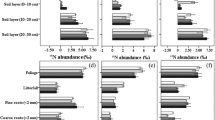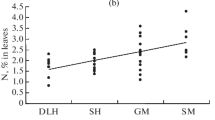Abstract
Nitrogen isotopes (15N/14N ratios, expressed as δ15N values) are useful markers of the mycorrhizal role in plant nitrogen supply because discrimination against 15N during creation of transfer compounds within mycorrhizal fungi decreases the 15N/14N in plants (low δ15N) and increases the 15N/14N of the fungi (high δ15N). Analytical models of 15N distribution would be helpful in interpreting δ15N patterns in fungi and plants. To compare different analytical models, we measured nitrogen isotope patterns in soils, saprotrophic fungi, ectomycorrhizal fungi, and plants with different mycorrhizal habits on a glacier foreland exposed during the last 100 years of glacial retreat and on adjacent non-glaciated terrain. Since plants during early primary succession may have only limited access to propagules of mycorrhizal fungi, we hypothesized that mycorrhizal plants would initially be similar to nonmycorrhizal plants in δ15N and then decrease, if mycorrhizal colonization were an important factor influencing plant δ15N. As hypothesized, plants with different mycorrhizal habits initially showed similar δ15N values (−4 to −6‰ relative to the standard of atmospheric N2 at 0‰), corresponding to low mycorrhizal colonization in all plant species and an absence of ectomycorrhizal sporocarps. In later successional stages where ectomycorrhizal sporocarps were present, most ectomycorrhizal and ericoid mycorrhizal plants declined by 5–6‰ in δ15N, suggesting transfer of 15N-depleted N from fungi to plants. The values recorded (−8 to −11‰) are among the lowest yet observed in vascular plants. In contrast, the δ15N of nonmycorrhizal plants and arbuscular mycorrhizal plants declined only slightly or not at all. On the forefront, most ectomycorrhizal and saprotrophic fungi were similar in δ15N (−1 to −3‰), but the host-specific ectomycorrhizal fungus Cortinarius tenebricus had values of up to 7‰. Plants, fungi and soil were at least 4‰ higher in δ15N from the mature site than in recently exposed sites. On both the forefront and the mature site, host-specific ectomycorrhizal fungi had higher δ15N values than ectomycorrhizal fungi with a broad host range. From these isotopic patterns, we conclude:(1) large enrichments in 15N of many ectomycorrhizal fungi relative to co-occurring ectomycorrhizal plants are best explained by treating the plant-fungal-soil system as a closed system with a discrimination against 15N of 8–10‰ during transfer from fungi to plants, (2) based on models of 15N mass balance, ericoid and ectomycorrhizal fungi retain up to two-thirds of the N in the plant-mycorrhizal system under the N-limited conditions at forefront sites, (3) sporocarps are probably enriched in 15N by an additional 3‰ relative to available nitrogen, and (4) host-specific ectomycorrhizal fungi may transfer more N to plant hosts than non-host-specific ectomycorrhizal fungi. Our study confirms that nitrogen isotopes are a powerful tool for probing nitrogen dynamics between mycorrhizal fungi and associated plants.




Similar content being viewed by others
References
Bago B, Pfeffer P, Shachar-Hill Y (2001) Could the urea cycle be translocating nitrogen in the arbuscular mycorrhizal symbiosis? New Phytol 149:4–8
Caldwell BA, Jumpponen A, Trappe JM (2000) Utilization of major detrital substrates by dark-septate, root endophytes. Mycologia 92:230–232
Carrillo JH, Hastings MG, Sigman DM, Huebert BJ (2002) Atmospheric deposition of inorganic and organic nitrogen and base cations in Hawaii. Glob Biogeochem Cycle 16:24, 1–16
Cázares E, Trappe JM, Jumpponen A (2005) Mycorrhiza-plant colonization patterns on a subalpine glacier forefront as a model system of primary succession. Mycorrhiza (DOI: 10.1007/s00572-004-0342-1)
Deacon JW (1997) Modern mycology, 3rd edn. Blackwell, London
Evans RD, Belnap J (1999) Long-term consequences of disturbance on nitrogen dynamics in an arid ecosystem. Ecology 80:150–160
Evans RD, Bloom AJ, Sukrapanna SS, Ehleringer JR (1996) Nitrogen isotope composition of tomato (Lycopersicon esculentum Mill. cv. T-5) grown under ammonium or nitrate nutrition. Plant Cell Environ 19:1317–1323
Fogel ML, Cifuentes LA (1993) Isotope fractionation during primary production. In: Macko SA, Engel MH (eds) Organic geochemistry. Plenum, New York, pp 73–98
Handley LL, Brendel O, Scrimgeour CM, Schmidt S, Raven JA, Turnbull MH, Stewart GR (1996) The 15N natural abundance patterns of field-collected fungi from three kinds of ecosystems. Rapid Commun Mass Spec 10:974–978
Handley LL, Austin AT, Robinson D, Scrimgeour CM, Raven JA, Heaton THE, Schmidt S, Stewart GR (1999) The 15N natural abundance (15N) of ecosystem samples reflects measures of water availability. Aust J Plant Physiol 26:185–199
Hayes JM (2002) Fractionation of the isotopes of carbon and hydrogen in biosynthetic processes. In: Valley JW, Cole DR (eds) Stable isotope geochemistry. Mineralogical Society of America and the Geochemical Society, Washington, pp 225–277
Helm DJ, Allen EB, Trappe JM (1996) Mycorrhizal chronosequence near Exit Glacier, Alaska. Can J Bot 74:1496–1506
Henn MR, Chapela IH (2001) Ecophysiology of 13 C and 15N isotopic fractionation in forest fungi and the roots of the saprotrophic-mycorrhizal divide. Oecologia 128:480–487
Hobbie EA (2005) Assessing functions of soil microbes with isotopic measurements. In: Buscot F, Varma A (eds) Micro-organisms in soils: roles in genesis and functions. Springer, Berlin, Heidelberg New York, pp 383–402
Hobbie EA, Colpaert JV (2003) Nitrogen availability and colonization by mycorrhizal fungi correlate with nitrogen isotope patterns in plants. New Phytol 157:115–126
Hobbie EA, Macko SA, Shugart HH (1999) Insights into nitrogen and carbon dynamics of ectomycorrhizal and saprotrophic fungi from isotopic evidence. Oecologia 118:353–360
Hobbie EA, Macko SA, Williams M (2000) Correlations between foliar δ15N and nitrogen concentrations may indicate plant-mycorrhizal interactions. Oecologia 122:273–283
Hobbie EA, Weber NS, Trappe JM (2001) Determining mycorrhizal or saprotrophic status of fungi from isotopic evidence: implications for element cycling and fungal evolution. New Phytol 150:601–610
Högberg P (1997) 15N natural abundance in soil-plant systems. New Phytol 137:179–203
Holloway JM, Dahlgren RA (2002) Nitrogen in rock: occurrences and biogeochemical implications. Glob Biogeochem Cycle 16:65, 1–17
Jumpponen A, Trappe JM (1998) Dark septate endophytes: a review of facultative biotrophic root-colonizing fungi. New Phytol 140:295–310
Jumpponen A, Mattson K, Trappe JM, Ohtonen R (1998) Effects of established willows on primary succession on Lyman Glacier Forefront, North Cascade Range, Washington, U.S.A.: evidence for simultaneous canopy inhibition and soil facilitation. Arctic Alpine Res 30:31–39
Jumpponen A, Trappe JM, Cázares E (2002) Occurrence of ectomycorrhizal fungi on the forefront of retreating Lyman Glacier (Washington, USA) in relation to time since deglaciation. Mycorrhiza 12:43–49
Kohls SJ, Van Kessel C, Baker DD, Grigal DF, Lawrence DB (1994) Assessment of N2 fixation and N cycling by Dryas along a chronosequence within the forelands of the Athabasca Glacier, Canada. Soil Biol Biochem 26:623–632
Kohls SJ, Baker DD, van Kessel C, Dawson JO (2003) An assessment of soil enrichment by actinorrhizal N2 fixation using δ15N values in a chronosequence of deglaciation at Glacier Bay, Alaska. Plant Soil 254:11–17
Kohzu A, Yoshioka T, Ando T, Takahashi M, Koba K, Wada E (1999) Natural 13 C and 15N abundance of field-collected fungi and their ecological implications. New Phytol 144:323–330
Kohzu A, Tateishi T, Yamada A, Koba K, Wada E (2000) Nitrogen isotope fractionation during nitrogen transport from ectomycorrhizal fungi, Suillus granulatus, to the host plant, Pinus densiflora. Soil Sci Plant Nutr 46:733–739
Lilleskov EA, Hobbie EA, Fahey TJ (2002) Ectomycorrizal fungal taxa differing in response to nitrogen deposition also differ in pure culture organic nitrogen use and natural abundance of nitrogen isotopes. New Phytol 154:219–231
Martinelli LA, Piccolo MC, Townsend AR, Vitousek PM, Cuevas E, McDowell W, Robertson GP, Santos OC, Treseder K (1999) Nitrogen stable isotopic composition of leaves and soil: tropical versus temperate forests. Biogeochemistry 46:45–65
McKane RB, Johnson LC, Shaver GR, Nadelhoffer KJ, Rastetter EB, Fry B, Giblin AE, Kielland K, Kwiatkowski BL, Laundre JA, Murray G (2002) Resource-based niches provide a basis for plant species diversity and dominance in arctic tundra. Nature 415:68–71
Michelsen A, Schmidt IK, Jonasson S, Quarmby C, Sleep D (1996) Leaf 15N abundance of subarctic plants provides field evidence that ericoid, ectomycorrhizal and non- and arbuscular mycorrhizal species access different sources of soil nitrogen. Oecologia 105:53–63
Michelsen A, Quarmby C, Sleep D, Jonasson S (1998) Vascular plant 15N natural abundance in heath and forest tundra ecosystems is closely correlated with presence and type of mycorrhizal fungi in roots. Oecologia 115:406–418
Molina R, Massicotte H, Trappe JM (1992) Specificity phenomena in mycorrhizal symbioses: community-ecological consequences and practical implications. In: Allen MF (ed) Mycorrhizal functioning. Chapman & Hall, New York, pp 357–423
Nadelhoffer KJ, Fry B (1994) Nitrogen isotope studies in forest ecosystems. In: Lajtha K, Michener R (eds) Stable isotopes in ecology and environmental science. Blackwell, London, pp 22–44
Nara K, Nakaya H, Hogetsu T (2003) Ectomycorrhizal sporocarp succession and production during early primary succession on Mount Fuji. New Phytol 158:193–206
Read DJ (1991) Mycorrhizas in ecosystems. Experientia 47:376–391
Read DJ, Perez-Moreno J. (2003) Mycorrhizas and nutrient cycling in ecosystems - a journey towards relevance? New Phytol 157:475–492
Schmidt S, Stewart GR (1997) Waterlogging and fire impacts on nitrogen availability and utilization in a subtropical wet heathland (wallum). Plant Cell Environ 20:1231–1241
Simard SW, Durall D, Jones M (2002) Carbon and nutrient fluxes within and between mycorrhizal plants. In: van der Heijden MGA, Sanders IR (eds) Mycorrhizal ecology. Springer, Berlin, Heidelberg New York, pp 33–74
Taylor AFS, Högbom L, Högberg M, Lyon AJE, Näsholm T, Högberg P (1997) Natural 15N abundance in fruit bodies of ectomycorrhizal fungi from boreal forests. New Phytol 136:713–720
Taylor AFS, Fransson PM, Högberg P, Högberg MN, Plamboeck AH (2003) Species level patterns in C-13 and N-15 abundance of ectomycorrhizal and saprotrophic fungal sporocarps. New Phytol 159:757–774
Trappe JM (1977) Selection of fungi for ectomycorrhizal inoculation in nurseries. Ann Rev Phytopath 15:203–222
Trowbridge J, Jumpponen A (2004) Fungal colonization of shrub willow roots at the forefront of a receding glacier. Mycorrhiza 14:283–293
Trudell SA, Rygiewicz PT, Edmonds RL (2004) Patterns of nitrogen and carbon stable isotope ratios in macrofungi, plants and soils in two old-growth conifer forests. New Phytol 164:317–335
Vitousek PM, Shearer G, Kohl DH (1989) Foliar 15N natural abundance in Hawaiian rainforest: patterns and possible mechanisms. Oecologia 78:383–388
Acknowledgements
Our thanks to personnel of the Chelan Ranger District, Wenatchee National Forest for greatly facilitating this study, to the Oregon State University herbarium for loan of archived specimens, to Matt Trappe, Casey Corliss, Rauni Ohtonen, Goetz Palfner, and Kei Fujimora for assistance with field work, and to Steve Trudell for comments on an earlier manuscript draft. Casey Corliss, Bill Griffis, Willi Brand, Heike Geilmann, Steve Macko, and Marshall Otter assisted with sample processing and isotopic analyses. Funding was provided through the National Research Council (cooperative agreement CR-824072), the National Park Service, the U.S. National Science Foundation (DEB-0235727), and the U.S. Forest Service, Pacific Northwest Research Station.
Author information
Authors and Affiliations
Corresponding author
Additional information
Communicated by Todd Dawson
Rights and permissions
About this article
Cite this article
Hobbie, E.A., Jumpponen, A. & Trappe, J. Foliar and fungal 15 N:14 N ratios reflect development of mycorrhizae and nitrogen supply during primary succession: testing analytical models. Oecologia 146, 258–268 (2005). https://doi.org/10.1007/s00442-005-0208-z
Received:
Accepted:
Published:
Issue Date:
DOI: https://doi.org/10.1007/s00442-005-0208-z




